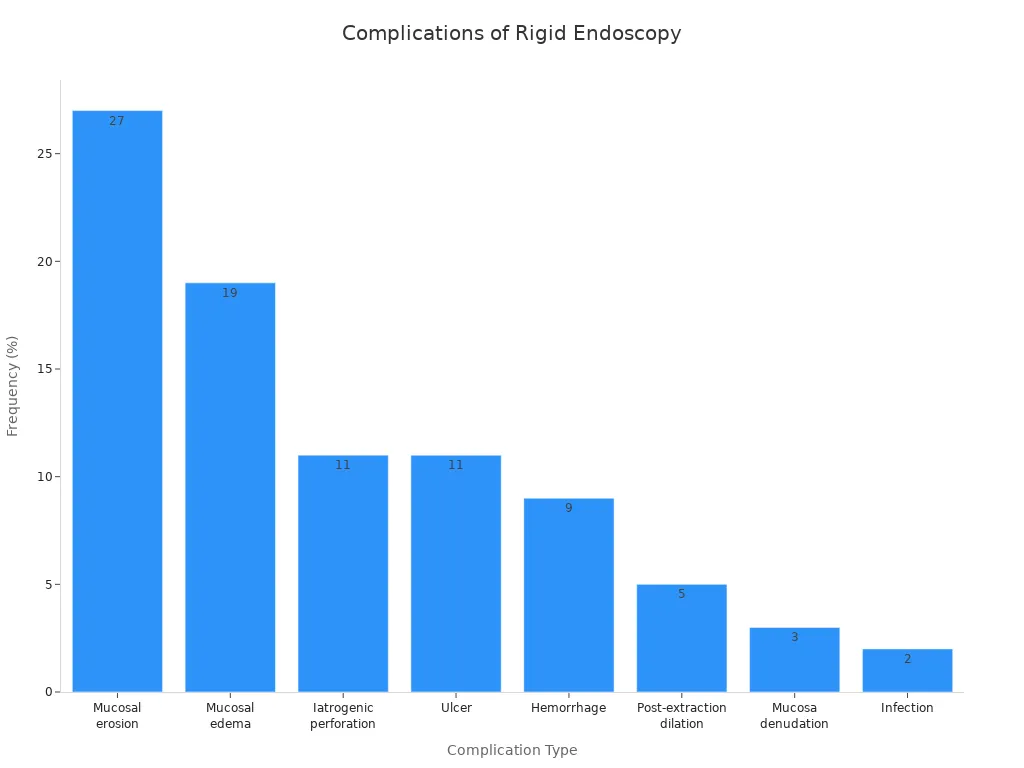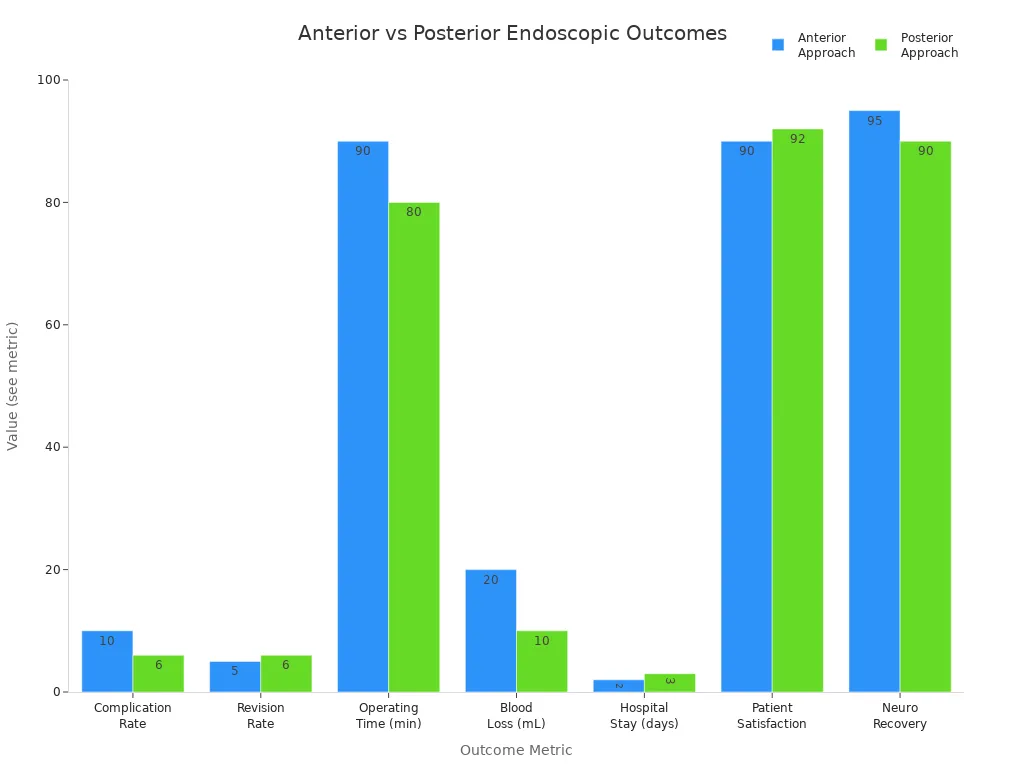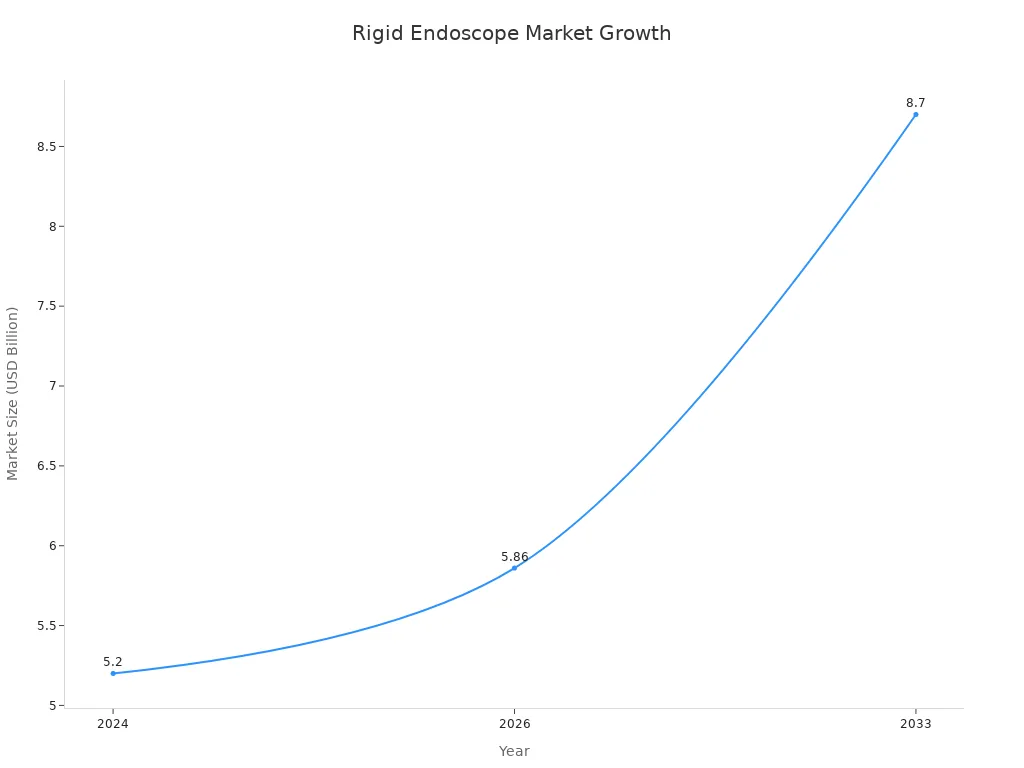Views: 0 Author: Site Editor Publish Time: 2025-08-29 Origin: Site











A rigid endoscope features a fixed-length, fixed-geometry design. You see strong metal tubes housing optical lenses and light channels, giving the instrument toughness and stability. This structure supports direct insertion and precise visualization, crucial for medical diagnostics and surgical accuracy. Unlike a flexible endoscope, the rigid endoscope does not bend, which ensures a stable, continuous view with common angles like 0, 30, and 70 degrees. Understanding these structural differences helps you select the right tool for various medical procedures.
Rigid endoscopes offer a stable, in-line arrangement of the light source and camera, which is essential for high image quality and brightness in medical applications.
Endoscope Type | Market Size 2024 (USD Billion) | Projected Market Size (USD Billion) | CAGR (%) |
|---|---|---|---|
Flexible Endoscopes | 12.41 | 17.63 (by 2030) | 5.96 (2025-2030) |
Rigid Endoscopes | 8.21 | 16.32 (by 2034) | 7.11 (2025-2034) |
Rigid endoscopes continue to grow in importance for endoscopy, even though flexible endoscopes currently hold a larger market share.
Rigid endoscopes have a solid metal tube design that provides stability and precise visualization during medical procedures.
The optical system inside uses rod lenses and prisms to deliver clear, bright images with fixed viewing angles like 0°, 30°, and 70°.
Rigid endoscopes are easier to clean and sterilize than flexible ones, reducing infection risks and supporting frequent use.
They offer high durability and support instrument channels for surgical tools, making them ideal for minimally invasive surgeries.
Choosing between rigid and flexible endoscopes depends on the procedure’s needs, anatomy, and required image quality for best patient outcomes.

A rigid endoscope stands out because of its solid, non-bendable design. You rely on this structure for procedures that demand precision and stability. Let’s break down the main components that make rigid tube endoscopes essential in medical practice.
The main body of a rigid endoscope consists of a strong metal tube. Manufacturers use metals like titanium and stainless steel for their toughness and resistance to corrosion. This metal tube acts as the backbone, protecting the delicate optical system inside. You benefit from this construction because it ensures the endoscope maintains its shape during insertion and manipulation. The rigid tube endoscopes typically measure about 30 centimeters in length and 1 centimeter in diameter, making them easy to handle in various medical settings. The choice of metal is critical. It allows the rigid endoscope to withstand repeated sterilization and frequent use without losing integrity. Some models may also incorporate plastics or optical-grade glass for specific parts, but the core remains metal for strength and precision.
Note: The rigid, non-bendable nature of the rigid endoscope provides unmatched control and accuracy during medical procedures.
Inside the rigid tube, you find a sophisticated optical system. Rigid endoscopes use a rod lens system, which transmits images from the tip to the eyepiece or camera port. These lenses, made from optical-grade glass, are separated by air spaces to enhance image clarity and magnification. Some designs use relay lenses or even gradient refractive index (GRIN) lenses, but the rod lens system remains the gold standard for image quality. Prisms at the tip can provide angled views, such as 30° or 70°, giving you flexibility in visualizing hard-to-reach areas. The diameter of the lens system affects image brightness and field of view, both crucial for accurate diagnosis and treatment in rigid endoscopy.
A rigid endoscope includes a light guide, usually made of optical fibers, that channels illumination from an external light source to the surgical site. This feature ensures you have a bright, clear view of internal structures. The light guide runs parallel to the optical system inside the rigid tube. High-quality illumination is essential for distinguishing tissues and identifying abnormalities during medical procedures. Advances in light guide technology, such as improved fiber optics and LED sources, have further enhanced the performance of rigid tube endoscopes.
At the proximal end of the rigid endoscope, you find either an eyepiece or a camera port. The eyepiece allows you to view images directly, while the camera port connects to digital imaging systems for display on monitors. Modern rigid endoscopes often feature modular designs, letting you switch between direct viewing and camera attachment. This flexibility supports a wide range of medical applications, from simple diagnostic exams to complex surgeries. The design of the camera port and adapters ensures compatibility with various imaging systems, making rigid tube endoscopes versatile tools in the operating room.
Some rigid endoscopes include an instrument channel, especially those used in surgical procedures. This channel runs alongside the optical system and light guide, allowing you to introduce surgical instruments or irrigation fluids directly through the rigid-tube endoscope. The instrument channel is vital for minimally invasive interventions, such as arthroscopy or laparoscopy. It enables you to perform biopsies, remove tissue, or deliver treatments without needing a separate incision. The presence of an instrument channel expands the capabilities of rigid endoscopes, making them indispensable in many medical specialties.
Tip: Always handle rigid endoscopes with care. Most failures occur from improper handling, especially at the eyepiece and distal lens. Proper training and maintenance extend the lifespan of your equipment.
You notice clear structural differences when comparing a rigid endoscope to flexible tube endoscopes. The rigid version uses a solid metal tube with fixed optical pathways, offering strength and stability. In contrast, a flexible endoscope features a pliable insertion tube, fiber-optic bundles, and articulation mechanisms that allow bending up to 180 degrees. This flexibility lets you navigate curved anatomical pathways, which is not possible with a rigid device. The table below highlights these differences:
Feature | Rigid Endoscope | Flexible Tube Endoscopes |
|---|---|---|
Construction | Solid metal tube, fixed geometry | Pliable tube, fiber-optic bundles, bending section |
Maneuverability | Fixed, limited insertion depth | 180-degree bending, navigates curves |
Components | Five core components | Six elements, including manipulation controls |
Clinical Use | Stability for orthopedic/abdominal use | Flexibility for hollow organs (colon, bronchi) |
These structural differences determine which endoscope you select for specific medical procedures.
When you use a rigid endoscope, you benefit from high image quality and clarity. The straight optical path and advanced lens systems deliver sharp, stable images, which are essential for surgeries that require precision. Flexible tube endoscopes offer more maneuverability, but their image quality may not always match the clarity of rigid devices. However, some studies show that flexible endoscopy can achieve image resolution comparable to rigid scopes in certain procedures. You should always consider the quality needed for your medical application.
Cleaning and sterilizing flexible tube endoscopes requires more time and care than rigid models. Flexible endoscopes have complex internal channels and bending mechanisms. You must follow a multi-step process: precleaning, leak testing, manual cleaning, high-level disinfection, and careful storage. In contrast, the rigid endoscope has a simpler structure, so you can clean and sterilize it more easily using standard methods. This difference reduces the risk of contamination and makes rigid devices more practical for frequent use.
Durability is a key factor in your choice of endoscope. The rigid endoscope, with its metal construction, withstands repeated sterilization and handling. Flexible tube endoscopes, while offering greater maneuverability, are more delicate and prone to damage. Repairs for flexible endoscopes can be expensive and frequent, especially if mishandled. You should weigh the advantages and disadvantages of each type based on your clinical needs and the expected lifespan of the device.
Tip: Always match the endoscope type to the procedure. Use flexible tube endoscopes for exploring curved or narrow body regions, and choose rigid models for procedures that demand stability and high image quality.
You often use a rigid endoscope in a variety of medical settings. This device plays a key role in orthopedic procedures, such as arthroscopy, where you examine joints like the knee or shoulder. In otolaryngology, you rely on rigid endoscopes for microlaryngeal surgery and sinus examinations. Surgeons also use them for inspecting body cavities during laparoscopy and for removing esophageal foreign bodies. These endoscopic procedures allow you to perform minimally invasive surgical procedures, reducing patient recovery time and hospital stays. When you need to perform an endoscopic examination of straight or easily accessible anatomical regions, a rigid endoscope provides the stability and image quality you require.
Note: Flexible endoscopes are preferred for navigating the intestines, bronchial tree, or other curved pathways where a rigid device cannot reach.
Rigid endoscopes offer several advantages and disadvantages in surgical procedures. You benefit from direct visualization, which helps you identify diseased areas with precision. The instrument channels let you introduce surgical tools, suction, or fluids, expanding your options during surgical operations. A recent clinical study on emergency airway management showed that using a rigid endoscope for tracheal stenosis resulted in high success rates, with all patients experiencing relief and no complications. The ability to use different angles, such as 0°, 30°, or 70°, gives you multi-angle vision during microlaryngeal surgery. Enhanced imaging quality supports accurate diagnosis and treatment, especially in complex regions like the vocal cords.
Advantage | Explanation |
|---|---|
Direct visualization | Provides clear, real-time views of internal structures |
Instrument channels | Allows passage of surgical instruments and fluids |
Multi-angle vision | Offers flexible viewing angles for thorough assessment |
Enhanced imaging | Delivers high-resolution images for precise surgical procedures |
Despite their strengths, rigid endoscopes have limitations that you must consider. The rigid, linear structure restricts use in narrow or curved anatomical spaces, making some endoscopic procedures more difficult. This can impact patient outcomes if you cannot access the target area. Complications such as mucosal erosion, edema, or even iatrogenic perforation may occur, especially during removal of esophageal foreign bodies. The chart below shows the frequency of common complications:

You should also recognize that both rigid and flexible endoscopes have acceptable safety profiles, but the lack of direct comparison studies means you must weigh the advantages and disadvantages for each medical procedure. Always assess the patient’s anatomy and the clinical situation before selecting the appropriate endoscope for endoscopic procedures.
Selecting the right endoscope for a medical procedure requires you to weigh several important factors. You must consider the type of procedure, the anatomical area, and the level of tissue manipulation needed. Rigid endoscopes provide a stable platform for precise interventions, especially in sterile body cavities accessed through surgical incisions. Flexible endoscopes excel in maneuverability, allowing you to reach hidden or curved regions through natural body cavities. The following table highlights key differences to guide your decision:
Factor | Rigid Endoscope Characteristics | Flexible Endoscope Characteristics |
|---|---|---|
Maneuverability | Limited flexibility; high structural rigidity; stable working platform for tissue manipulation | Excellent maneuverability; flexible shaft; suitable for accessing difficult or hidden areas via natural cavities |
Anatomical Access | Used mainly for sterile body cavities accessed through surgical incisions (e.g., laparoscopy, arthroscopy) | Used through natural body cavities (e.g., gastroscopy, colonoscopy) |
Procedure Type | Ideal for therapeutic procedures requiring stability and manipulation | Primarily diagnostic but limited for tissue manipulation |
Cost of Ownership | High due to inventory, repair, sterilization, and downtime; single-use options emerging to reduce costs | Maintenance and repair can be costly; flexible scopes are delicate and require careful handling |
Sterilization & Reprocessing | Requires thorough sterilization; single-use rigid scopes reduce infection risk and reprocessing burden | Complex reprocessing due to flexible design; risk of damage during cleaning |
Equipment Availability & Support | OEM service critical for longevity; high-quality scopes provide better visualization and durability | OEM service important; flexible scopes have more delicate components |
Durability & Repairability | Durable if maintained properly; smaller diameter scopes break more often | More prone to damage due to flexibility; repair can be costly |
You should also evaluate the instrument channels and the specific needs of your medical specialty. Rigid endoscopes often lack multiple channels, while flexible models support air, water, suction, and biopsy tools. Your choice impacts not only the effectiveness of the procedure but also the overall cost and maintenance requirements.
Note: Understanding the structure and function of each endoscope type helps you make informed clinical decisions, improving both efficiency and patient safety.
Your decision to use a rigid or flexible endoscope directly affects patient outcomes. Rigid endoscopes offer high stiffness and a stable platform, which is essential for procedures that require precise tissue manipulation. Flexible endoscopes allow you to access complex anatomical regions, but they may not provide the same stability. The structure of the endoscope influences recovery times, complication rates, and patient satisfaction.

You see that minimally invasive approaches using the right endoscope structure can shorten hospital stays, reduce blood loss, and improve patient satisfaction. Both anterior and posterior approaches in endoscopic surgery show high rates of neurological recovery and pain relief. However, each method carries unique risks, such as transient dysphagia or minor neurological deficits. By understanding these differences, you can tailor your approach to maximize patient safety and optimize recovery.
Tip: Ongoing training and credentialing ensure you maintain competence in using advanced medical technology. Hospitals require you to document your skills, complete continuing education, and monitor outcomes to uphold the highest standards of safety.
A deep understanding of endoscope structure and medical technology supports evidence-based practice. When you apply the latest research and technology, you improve patient safety and deliver better care.
You see that the structure of an endoscope shapes its performance and suitability for different procedures. Rigid models deliver unmatched stability and image clarity, while flexible types offer greater access to curved anatomy. Your choice impacts patient outcomes and workflow efficiency. Market trends show rapid growth in minimally invasive surgery, driven by innovation and demand for safer, faster recovery.

Always match the endoscope’s structure to your clinical goals for optimal results.
You use a rigid endoscope to examine or operate inside body cavities that require stability and high image quality. Rigid endoscopes work best in procedures like arthroscopy, laparoscopy, and ENT surgeries.
A rigid endoscope features a solid metal tube that does not bend. You get superior image clarity and stability. Flexible endoscopes bend and navigate curved anatomy, but may not match the image quality of rigid endoscopes.
Yes. You can sterilize a rigid endoscope using standard autoclave or chemical methods. The metal construction of rigid endoscopes withstands repeated sterilization, making them reliable for frequent use.
A semi rigid endoscope combines features of both rigid endoscopes and flexible endoscopes. You get limited flexibility with a mostly straight shaft. Semi rigid endoscopes help you access slightly curved areas while maintaining some stability.
You select a rigid endoscope for surgery when you need precise control, direct visualization, and high-resolution images. Rigid endoscopes support instrument channels, allowing you to perform complex procedures with accuracy.
